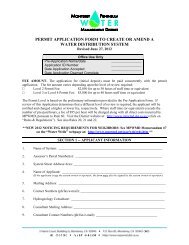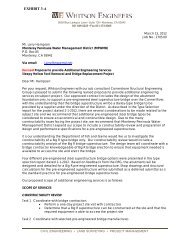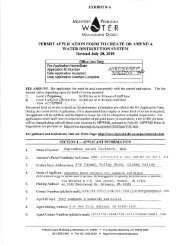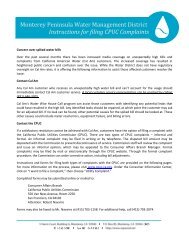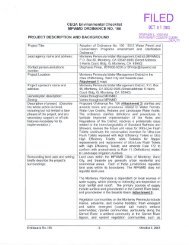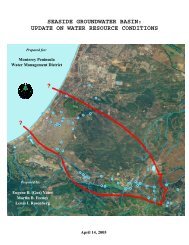FINAL REPORT Evaluation of Seawater Desalination Projects ...
FINAL REPORT Evaluation of Seawater Desalination Projects ...
FINAL REPORT Evaluation of Seawater Desalination Projects ...
You also want an ePaper? Increase the reach of your titles
YUMPU automatically turns print PDFs into web optimized ePapers that Google loves.
EVALUATION OF SEAWATER DESALINATION PROJECTS<br />
PROPOSED FOR THE MONTEREY PENINSULA<br />
considered surface water, the desalination plant must comply with these regulations. In<br />
addition, it is unlikely that 2-log disinfection <strong>of</strong> Giardia would be achievable in a contact<br />
tank, as the combination <strong>of</strong> high chlorine dosage and/or the large tank size necessary to<br />
achieve this inactivation would be extremely unusual in a water treatment plant.<br />
Nevertheless, the other log removal / inactivation credits suggested for the various processes<br />
relative to both Giardia and viruses are within the range <strong>of</strong> those typically permitted by the<br />
CDHS, and a 0.5-log Giardia inactivation using free chlorine, as required by the CDHS<br />
under its policy <strong>of</strong> providing multiple barrier protection, is reasonable to expect in the<br />
desalination plant’s contact tank. Moreover, the removal <strong>of</strong> Cryptosporidium permitted by<br />
the CDHS is typically similar to that for Giardia. Thus, despite the inaccuracies in<br />
Poseidon’s analysis <strong>of</strong> pathogen reduction, it is likely that the proposed combination <strong>of</strong><br />
treatment processes would be sufficient to achieve the requisite pathogen removal.<br />
The CDR indicates that chloramines will be added downstream <strong>of</strong> the product water storage<br />
tank, and that the product water transfer line would provide adequate contact time to comply<br />
with CDHS disinfection requirements. Chloramines constitute a relatively weak primary<br />
disinfectant, however, and no supporting detail is provided to justify its use, particularly in a<br />
30<br />
water transfer line. Supplemental information provided by Poseidon Resources in a letter<br />
dated July 14, 2006, tacitly refutes the CDR, specifying that free chlorine (vs. chloramines)<br />
will be applied in the product water storage tank (vs. the water transfer line) to achieve<br />
primary disinfection. In addition, the letter notes that if all purchasers <strong>of</strong> the water from the<br />
desalination plant utilize either chlorine or chloramines as a residual disinfectant, then the<br />
MBRSDP will likewise apply this disinfectant at the effluent <strong>of</strong> the plant. If the various<br />
purchasers do not each use the same residual (i.e., secondary) disinfectant, however, then<br />
only free chlorine will be used. In the latter case, each purchaser using chloramines would be<br />
obligated to provide facilities for applying ammonia to the delivered water at its own cost.<br />
Likewise, the CDR notes that pesticides and agricultural run<strong>of</strong>f will not be a factor for source<br />
water quality, but there is no rationale to substantiate this assertion. 31 A full water quality<br />
analysis for all regulated drinking water contaminants should be conducted during the<br />
piloting phase prior to full-scale project implementation. The CDR does cite low total<br />
organic carbon (TOC) levels (more consistent with typical ambient seawater concentrations<br />
than those reported by Duke Energy for its Moss Landing Harbor Units 6 and 7 intake and<br />
discharge), and coupled with the use <strong>of</strong> coagulation and polymer in the pretreatment process<br />
prior to any chlorine addition, the formation <strong>of</strong> chlorinated disinfection by-products should<br />
not be an issue.<br />
31 In a June 28, 2006 email, a representative <strong>of</strong> Poseidon Resources stated that monthly water quality<br />
monitoring has been conducted since October 2005. The program has included collecting seawater samples<br />
from the Moss Landing Harbor. The samples were tested for 300 constituents including pesticides and other<br />
agricultural run<strong>of</strong>f constituents, as regulated under the California Ocean Plan and the state and federal Safe<br />
Drinking Water Acts. Poseidon Resources concluded from the testing program that pesticides and agricultural<br />
run<strong>of</strong>f will not be a factor. The data provided by Poseidon Resources do not support this conclusion.<br />
Monterey Peninsula Water Management District 4-4



